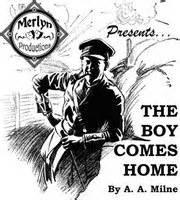A.A. Milne, renowned for creating the beloved Winnie-the-Pooh series, showcases a different facet of his literary prowess in "The Boy Comes Home." This delightful work, written in the aftermath of World War I, presents a charming narrative that explores the complexities of returning home after experiencing the trials of war. In this blog post, we'll delve into the essence of "The Boy Comes Home," providing a summary and examining the themes that make this piece a timeless gem.
Summary:
"The Boy Comes Home" unfolds as the protagonist, James Milne, returns to his family after serving in the Great War. The story captures the essence of the post-war period, marked by a palpable mix of relief and disorientation. James, now a decorated soldier, faces the challenge of reintegrating into civilian life, navigating the expectations of family and society.
The narrative follows James's attempts to reconcile the changed dynamics of his family, the expectations placed upon him, and his own internal conflicts. As the story unfolds, readers are treated to a poignant exploration of the emotional and psychological toll of war, coupled with Milne's signature wit and humor.
Themes:
1. Homecoming and Reintegration:
Milne delicately examines the complexities of returning home after a significant period away. James's attempts to fit into the familiar yet altered family dynamic reflect the challenges faced by many veterans during post-war periods. The story highlights the nuances of reintegration, capturing both the joyous reunions and the struggles of readjusting to civilian life.
2. The Impact of War:
Through James's character, Milne provides a glimpse into the lasting effects of war on the individual psyche. The juxtaposition of the battlefield heroism and the mundane challenges of everyday life creates a poignant contrast, emphasizing the profound impact of war on the human spirit.
3. Social Expectations:
The narrative subtly addresses societal expectations placed upon returning soldiers. James grapples with the pressure to conform to predefined roles and expectations, mirroring the experiences of many individuals trying to find their place in a society forever changed by the war.
4. Humor and Satire:
True to Milne's style, "The Boy Comes Home" is infused with humor and satire. The author uses wit to navigate serious themes, providing a lighthearted yet thought-provoking perspective on the challenges of post-war life. The humor serves as a coping mechanism for both the characters and readers, offering a nuanced exploration of difficult subject matter.
Milne's Narrative Craftsmanship:
A.A. Milne's ability to seamlessly blend humor with profound themes is evident in "The Boy Comes Home." The narrative unfolds with a gentle cadence, allowing readers to connect with James's journey on a personal level. Milne's keen observations of human nature and society shine through, creating a narrative that resonates with universal truths while maintaining a distinctly British charm.
Conclusion:
"The Boy Comes Home" stands as a testament to A.A. Milne's versatility as a writer. While he is widely celebrated for his enchanting tales of the Hundred Acre Wood, this lesser-known work showcases his ability to tackle serious themes with grace and humor. As we accompany James on his journey of homecoming, we find ourselves immersed in a narrative that transcends time, offering insights into the complexities of human emotions and the indomitable spirit of those who navigate the challenges of returning home after war. In the end, "The Boy Comes Home" remains a timeless gem that invites readers to reflect on the enduring impact of war and the resilience of the human spirit.



No comments:
Post a Comment